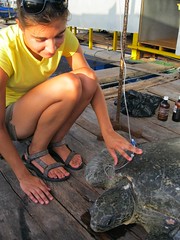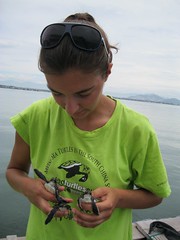Recent College of Agricultural Science graduate Kasey Moore not only received a B.S. in Fisheries and Wildlife Sciences from OSU, but also had the opportunity to study abroad twice during her college career. As a sophomore, Kasey traveled to Valdivia, Chile to study at La Universidad Austral de Chile for a term, and during fall of her senior year Kasey hopped on a plane again, but this time to Africa to participate in the School for Field Studies’ Wildlife Management Studies program. Now, having explored the world as an undergraduate, Kasey is embarking on her grandest adventure yet—traveling the world with Cavalia.
Most people find a job within their related field of study after they graduate from college. This is how I imagined my life after college would go, but things took an unexpected turn a couple of months prior to graduation. Instead of moving straight into a job within the field of fisheries and wildlife science, I will be running away and joining the traveling circu s.
s.
The show is called “Cavalia” and was created by Normand Latourelle, who was also one of the original co-founders and managing director of Cirque du Soleil. Cavalia is very similar to many of the other Cirque du Soleil shows, except for the fact that there are horses as well as acrobats in the performances. The main idea behind the show is to give tribute to the relationship between horses and humans and to document their place in history through an artistic and visually stunning performance.
I first heard about this job opportunity through an old friend of mine who I grew up riding with in the United States Pony Club. She is currently on tour with Cavalia and working as one of the team’s veterinary technicians, and in April she sent a post out on the Oregon Region’s Pony Club Facebook page advertising the position opening. This seemed like the perfect fit for me, as it incorporated the two things I am most passionate about: traveling and  horses. I have spent most of my life around horses and involved in the world of 3-day eventing and dressage. My 13 years of involvement with Pony Club has allowed me to achieve all 10 certifications within the organization, and given me countless valuable skills for working in the horse industry. I have also been lucky enough to participate in two study abroad programs during my four years at Oregon State. The first was in Chile during my sophomore year, and the second was a program through the School for Field Studies in Kenya and Tanzania during my senior year.
horses. I have spent most of my life around horses and involved in the world of 3-day eventing and dressage. My 13 years of involvement with Pony Club has allowed me to achieve all 10 certifications within the organization, and given me countless valuable skills for working in the horse industry. I have also been lucky enough to participate in two study abroad programs during my four years at Oregon State. The first was in Chile during my sophomore year, and the second was a program through the School for Field Studies in Kenya and Tanzania during my senior year.
Both my horse and travel experiences helped me to obtain this position within Cavalia, and now everything is becoming very real. I will be leaving for  Brussels, Belgium two days after OSU’s spring commencement ceremony and begin my journey working for this incredible show! I will be working as a groom, meaning I will be taking care of the 47 horses that Cavalia has as they tour the world. Daily routines will include basic barn chores, exercising and warming up some of the horses before each show, and getting the horses ready for each of their evening performances. After the show ends in Belgium, our next stop will be Singapore, and then other major cities throughout Asia for the remainder of the year. Needless to say, I am extremely excited for this opportunity and to work with these talented horses and tour the world at the same time!
Brussels, Belgium two days after OSU’s spring commencement ceremony and begin my journey working for this incredible show! I will be working as a groom, meaning I will be taking care of the 47 horses that Cavalia has as they tour the world. Daily routines will include basic barn chores, exercising and warming up some of the horses before each show, and getting the horses ready for each of their evening performances. After the show ends in Belgium, our next stop will be Singapore, and then other major cities throughout Asia for the remainder of the year. Needless to say, I am extremely excited for this opportunity and to work with these talented horses and tour the world at the same time!
For more information on Cavalia and their touring schedule, visit: http://www.cavalia.net/en











